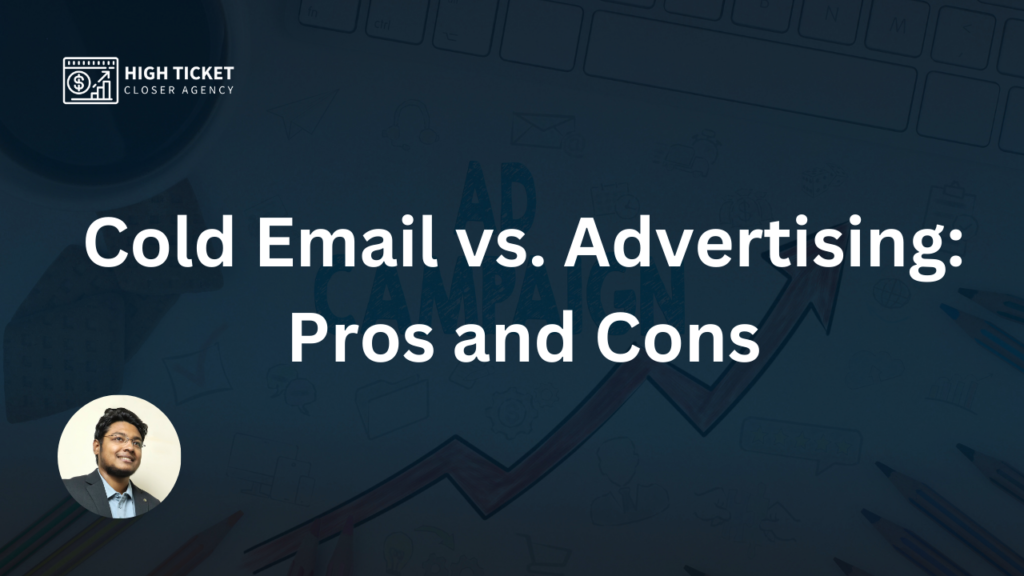In the ever-evolving world of marketing, two powerful strategies must be Cold Email and Advertising.
Both methods offer distinct advantages and challenges, making it crucial for businesses to consider which approach aligns best with their objectives and target audience.
Cold Email vs. Advertising
Let’s explore the pros and cons of Cold Email and Advertising to help you make the best decision for your marketing campaigns.
Cold Email:
Pros:
- Personalization: Cold Email allows for highly personalized messages tailored to individual recipients, increasing the chances of capturing their attention and interest.
- Cost-Effectiveness: Cold Email can be an economical alternative to traditional advertising, as it eliminates the need for expensive ad space and media placements.
- Direct Engagement: With Cold Email, businesses can directly engage potential clients and build one-on-one relationships, fostering a sense of trust and credibility.
- Nurturing Warm Leads: Cold Email enables businesses to nurture warm leads, providing engaging content and guiding prospects through the sales funnel.
- Measurable Results: Cold Email campaigns can be easily tracked and measured, allowing businesses to assess the effectiveness of their outreach efforts and make data-driven decisions.
Cons:
- Risk of Spam: If not executed carefully, Cold Email campaigns can be flagged as spam, leading to negative brand perception and potentially affecting deliverability rates.
- Time-Consuming: Crafting personalized Cold Emails takes time and effort, especially when targeting a large audience, which may not be suitable for businesses with limited resources.
- Lower Open Rates: Cold Emails may have lower open rates compared to targeted ads, as email inboxes can be inundated with messages, leading to potential oversight by recipients.
Advertising:
Pros:
- Wide Reach: Advertising provides businesses with the opportunity to reach a vast audience, enhancing brand visibility and awareness on various platforms.
- Instant Impact: Well-designed ads can capture attention immediately, conveying essential messages and calls to action efficiently.
- A/B Testing: Advertising allows businesses to conduct A/B testing, optimizing campaigns based on real-time data to maximize results.
- Various Ad Formats: Businesses can choose from diverse ad formats, including display ads, video ads, sponsored content, and more, catering to different marketing objectives.
- Brand Recognition: Consistent advertising campaigns can reinforce brand identity and recognition, creating a lasting impression on the target audience.
Cons:
- Costly Investment: Advertising, especially on popular platforms, can be expensive, making it inappropriate for small businesses with limited marketing budgets.
- Ad Blockers: With the number of available free and paid ad blockers, some users may not see ads, reducing your potential impact and ROI.
- Ad Fatigue: Frequent exposure to the same ad can lead to ad fatigue, where the target audience becomes desensitized to the message, affecting engagement rates.
- Limited Engagement: Unlike Cold Email, advertising lacks direct engagement with individual prospects, potentially hindering relationship-building efforts.
Which one is better?
Both Cold Email and Advertising are powerful marketing tools, each with its own set of advantages and challenges.
So far, for small agencies with a limited budget, Cold Email is generally a better option to start getting clients.
Cold Email allows for personalized outreach, cost-effectiveness, and direct engagement, making it an ideal choice for building one-on-one connections and nurturing warm leads without the high costs associated with advertising.
I’m Md Tangeer Mehedi, and I’ve been actively engaged in cold emailing for the past three years. My primary focus is appointment setting with B2B clients and helping businesses set up their cold email systems. In this blog, I will share real-life problems I’ve encountered in my work and provide solutions to these challenges. I hope you enjoy reading my blog and find it helpful.

